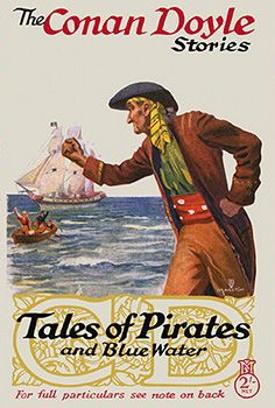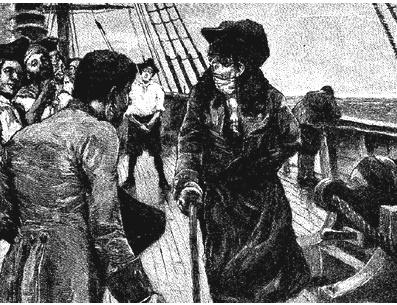Book Review by George S: This 1922 volume contains stories written by Doyle over a long period, and the most striking are the four about the evil pirate Sharkey, set mostly in the Caribbean during the early eighteenth century.

In the course of them, Doyle presents a potted history of the Caribbean. He depicts it as a violent place, where there has been a degeneration from the age of the merchant adventurers, by way of the age of the buccaneers (privateers who flourished during the European wars, taking prizes from combatant countries) until:
They, too, passed with their fleets and their sacking of cities, to make room for the worst of all, the lonely, outcast pirate, the bloody Ishmael of the seas, at war with the whole human race. This was the vile brood which the early eighteenth century had spawned forth, and of them all there was none who could compare in audacity, wickedness, and evil repute with the unutterable Sharkey.
Sharkey is a figure of pure evil, with no redeeming features. His appearance is repellent, especially
those filmy blue eyes, red-rimmed like those of a white bull-terrier, from which strong men winced away in fear and loathing. His bony hands, with long, thin fingers which quivered ceaselessly like the antennae of an insect, were toying constantly with the cards and the heap of gold moidores which lay before him.
The first story is told with the kind of dramatic irony that makes the reader complicit with the author in realising what the characters do not know.
Captain Scarrow's ship arrives at St Kitts just as Sharkey is about to be hanged, but it must make a speedy departure before the pirate 'does the rogue's hornpipe' on the gallows. The ship waits only to pick up the Governor of St Kitts, who has been unwell. As soon as the governor boards ship, the alert reader notices that his odd appearance must be a disguise.
He wore a Ramillies wig, all twisted into little tails like a poodle's coat, and cut so low across the brow that the large green glasses which covered his eyes looked as if they were hung from it. A fierce beak of a nose, very long and very thin, cut the air in front of him. His ague had caused him to swathe his throat and chin with a broad linen cravat.
 Illustration from McLure's Magazine, 1897
Illustration from McLure's Magazine, 1897
As the story progresses, it becomes increasingly clear that this passenger is of course the vile Sharkey, who has evaded the gallows - and who who in the end will survive to do mischief another day.
The first story having established Sharkey as a figure of ultimate evil, the next three ask 'Is there anything that will get rid of him?' In the second, someone tries.
Stephen Craddock had been that most formidable person, the Puritan gone wrong. Sprung from a decent Salem family, his ill-doing seemed to be a recoil from the austerity of their religion, and he brought to vice all the physical strength and energy with which the virtues of his ancestors had endowed him.
He had been a slaver, and maybe even a pirate until religious conversion makes him righteous again, and he tries to trap Sharkey while the pirate's sip is 'careening' (having its bottom scraped). His plan backfires and Sharkey wins the day.
In the third story, Sharkey faces a mutiny from his crew, which is averted only when a prize vessel comes into view. The pirates capture the ship and murder the crew, but locked up below there is a prisoner, a beautiful girl. When she meets Sharkey, she seems delighted to see him, and embraces him. Then the ship's surgeon cries out:
"Look at her hand, Captain Sharkey!" he cried. "For the Lord's sake, look at her hand!"
Sharkey stared down at the hand which had fondled him. It was of a strange dead pallor, with a yellow shiny web betwixt the fingers. All over it was a white fluffy dust, like the flour of a new-baked loaf.
She has leprosy, and by embracing Sharkey has probably contaminated him. The fearful crew force both of them into a boat and desert them. Sharkey seems done for, but a while later another ship finds the skeleton of a girl washed up on a desert island, with signs that a man has been there and escaped somehow. Sharkey is still alive.
In the fourth story, Copley Banks, a sugar merchant, vows vengeance after Sharkey has attacked one of his ships and murdered his wife and children. He tries to defeat Sharkey by becoming as evil as the man himself. He gathers together a crew 'the scum of the port-men whose reputations were so vile that the lowest crimp would have been ashamed to furnish them.' and engages on a career of piracy. When he meets Sharkey, they work together:
That summer they went north as far as the Newfoundland Banks, and harried the New York traders and the whale-ships from New England. It was Copley Banks who captured the Liverpool ship, House of Hanover, but it was Sharkey who fastened her master to the windlass and pelted him to death with empty claret-bottles.
Gradually Banks gets Sharkey's confidence, and at last gets him alone, and takes spectacular vengeance. Sharkey is finished at last.
In these stories, the Caribbean is presented as a place of potential violence and disorder. Slavery is rarely mentioned, but sugar-trading is presened as a respectable occupation. Slave-trading is less respectable, but less obnoxious than piracy. The Caribbean is a place where Europeans behave with violence towards one another. One of the non-Sharkey stories tells of a cunningly-made treasure chest, primed to murder anyone who dares to rob it. The British administration does what it can to keep order (another of the non-Sharkey stories in this collection praises "the splendid discipline of the British service [...] at its best in such a crisis." But this cannot cope with the likes of Sharkey. The stories seem to be saying that to deal with a man so evil, you have to descend to his level, and become as wicked as him.
The stories are told with Doyle's usual skill and pace, with a wonderful gusto. He has a gift formelodrama, for striking detail and exciting plot-twists. I wish he'd written more pirate stories. These are well up to his usual standard.
